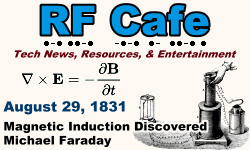|
  August 29 August 29
1831:
Michael
Faraday discovered the phenomenon of magnetic induction between wire coils wound
on a common iron core. 1842: The
design patent, a new form of patent was authorized by Act of Congress.
1866: A public demonstration was given at Mt. Washington, NH, of the first
cog railway in the
world. 1868:
Christian Schönbein, who discovered and named
ozone (O3) for its peculiar
smell (ozo is Greek for smell), died. 1876:
Charles Kettering,
co-founder of Delco Products and inventor of the electric starter and spark plugs for
cars, was born. 1949: The USSR tested its first atomic device, "First Lightning." 1949: At the University of Illinois, a
nuclear device
was used for the first time to treat cancer patients. 1965:
Gemini 5
astronaut Gordon Cooper in orbit 100 miles above the Earth held first conversation from
space with aquanaut
M. Scott Carpenter in Sealab II which was 205 feet below the surface
of the Pacific Ocean. 1967:
Charles Darrow, inventor of the board game
Monopoly, died. 1982: An
atom of a new element was made and was given the proposed name of
Meitnerium (symbol Mt). 1982: The "Transglobe
Expedition" was completed by Ranulph Fiennes and Charles Burton, who became the first
people to reach both poles by land. 1987:
Philip H. Smith, inventor of the Smith Chart, died. 2005: Category
5 Hurricane
Katrina made landfall in New Orleans, LA.
| Jan
| Feb | Mar |
Apr | May |
Jun | Jul |
Aug | Sep |
Oct | Nov |
Dec |
Note: These
historical tidbits have been collected from various sources, mostly on the Internet.
As detailed in
this article, there
is a lot of wrong information that is repeated hundreds of times because most websites
do not validate with authoritative sources. On RF Cafe, events with
hyperlinks have been verified. Many years ago,
I began commemorating the birthdays of notable people and events with
special RF Cafe logos.
Where available, I like to use images from postage stamps from the country where
the person or event occurred. Images used in the logos are often from open source
websites like Wikipedia, and are specifically credited with a hyperlink back to
the source where possible.
Fair Use laws permit
small samples of copyrighted content.
|










